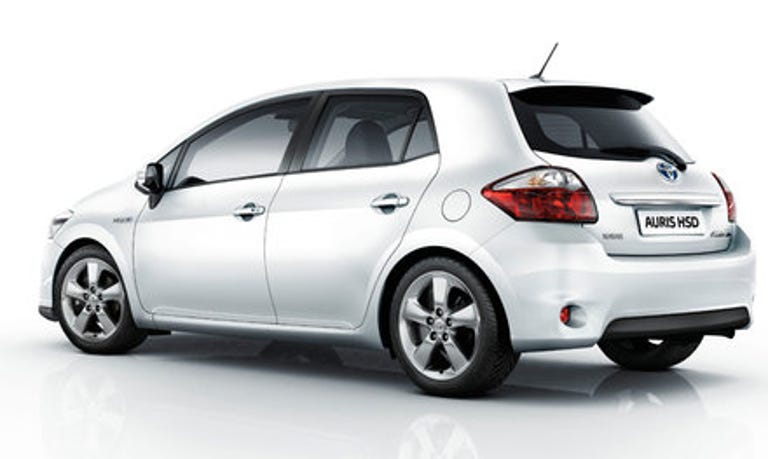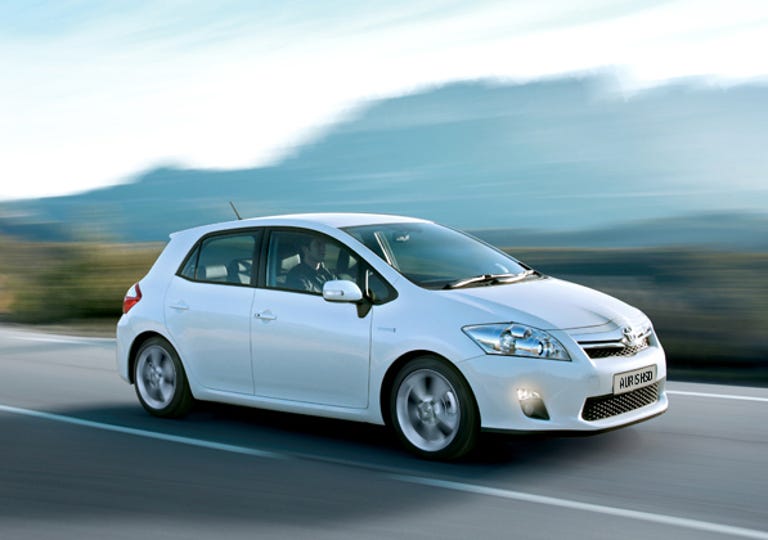 Why You Can Trust CNET
Why You Can Trust CNET Toyota Auris Hybrid review: Toyota Auris Hybrid
The Auris Hybrid is a very good small family car with exceptional fuel economy, low emissions and some fun cabin tech. It's just a shame it's so monumentally dull to look at.
Over 2 million Toyota hybrids have been sold globally since the launch of the Prius. By any measure, that's a great success, but the company believes hybrid sales would be even higher if it were to offer a hybrid car that was less expensive, smaller and -- crucially -- less weird-looking than the Prius.
The Good
The Bad
The Bottom Line
Enter the Auris Hybrid -- a greener, cleaner alternative to the hybrid car everyone loves to hate. It starts from £19,139, but the T-Spirit model we tested will set you back £20,882. Let's see how it measures up to its big ugly brother.
Watching paint dry
The Toyota Auris Hybrid could be one of the most exciting cars on the road, but you wouldn't give it a second glance. Not once during the seven days we tested the car did a single, solitary passer-by even cast a glance in its direction -- and who could blame them? The Auris, in hybrid form or not, is the most anonymous, derivative, lacklustre piece of design seen since Roger Federer invented beige.

We might as well have left several lines blank -- it would have the same effect as this picture.
Toyota told us this was entirely deliberate. Its designers said people find the Prius a little too unconventional, and the Auris was created to make a hybrid that looks more normal. We can see their point, but we'd rather drive a car that makes people look and inspires some kind of feeling, rather than cruise around in a thing so nondescript that nobody knows it exists.
Twin powers
But there's plenty of reason to get excited about the Auris Hybrid once you take a closer look. Under its bland little bonnet is the same Hybrid Synergy Drive setup found in the third-generation Prius.
Power comes from a 1.8-litre, 16-valve engine that uses the Atkinson cycle -- a method of internal combustion designed to prioritise efficiency at the expense of power. The engine's power is supplemented by a 60kW electric motor connected to a 202V, 6.5Ah nickel-metal hydride battery.
Unlike the Honda CR-Z, which is a mild hybrid, the Auris Hybrid is a full hybrid -- perhaps the only thing about it that isn't mild -- meaning it's capable of running on battery power alone (though only for 1.2 miles at a time and only at up to 30mph), on petrol power alone, or on a combination of petrol and electric power when more performance is desired.
Method to the madness
To the uninitiated user, the Auris drives like a normal automatic, but car geeks like us will be mesmerised by how the engine, motor and batteries work together as they drive.
Caress the accelerator pedal with your knitted hemp boots and it'll take off in almost complete silence, using the electric motor alone to get things moving. Things become a little noisier at higher speeds, however. The internal combustion engine kicks into life if you venture above 30mph, at lower speeds if your battery level is low, or from a standstill if you hammer the go-pedal in search of ultimate acceleration.
Occasionally, during sedate moments of driving, the electric motor will stop helping the car accelerate and instead act as a generator, soaking up excess power from the petrol engine and diverting it to the battery for later use. Cruise down a hill and it'll sip morsels of power from the car's regenerative braking system, turning heat energy that would otherwise be lost under braking into usable electricity that's stored in the battery.
Emissions statement
The Hybrid Synergy Drive system in the Auris Hybrid delivers exceptional fuel economy and low carbon dioxide emissions. The greenest of the three versions available, the Auris Hybrid T4 89g, emits -- you guessed it -- 89g of carbon dioxide per kilometre when equipped with 15-inch wheels. The T4 and the T Spirit models emit 93g/km due to their larger 17-inch wheels, but even so, that's a figure most non-hybrid cars can't even dream of achieving.
Fuel economy is equally impressive. The 15-inch wheeled T4 89g model achieves a whopping 74.3mpg, but even the models with 17-inch boots manage a very impressive 70.6mpg.
Easy does it
The Auris Hybrid continuously provides feedback about how economically you're driving via a power meter next to the speedometer. It behaves in much the same way as a rev counter -- the harder you accelerate, the further round the needle goes; the further the needle goes, the harder you're working the engine.
The power meter shows how economically you're driving, giving you something to aim for as you're pootling along.
More often than not, we found ourselves preferring to keep the car in the green zone. This had a lot to do with the desperate noise the Auris Hybrid makes when you hammer the accelerator pedal. It sounds like muscular hair dryer, whirring deeply, rather than roaring as it accelerates. It's not an offensive noise by any stretch of the imagination, but there really is more satisfaction to be had from eking out higher mpg than mph.
That not to say the Auris Hybrid is slow. Its 0-62mph time is a seemingly lethargic 11.4 seconds, but it feels as nippy as most everday family hatchbacks and can keep pace with even so-called sporty hybrids such as the Honda CR-Z.
It handles surprisingly well. Throw the car into a bend enthusiastically and it'll guide you around with surprising tenacity. Its suspension seems to acquire previously unseen levels of firmness, keeping body roll to a respectable minimum. It feels as if it'll cock an inside rear wheel if you push it too hard in a bend, but the stability control system is always on hand, cutting the power and keeping you from oversteering too dreadfully.
Cabin tech
Driving economically can be a dull affair, but luckily the Auris Hybrid has plenty of creature comforts to keep you happy. Its stereo system has a comprehensive feature list including Bluetooth audio streaming that lets you play Spotify, for example, from a phone over the car's speakers, a built-in 40GB hard drive for ripping audio CDs, a USB port for playing music stored on an external hard drive and an auxiliary port for connecting external audio sources.
The Auris Hybrid's sat-nav is less impressive than its audio system, however. Its maps, supplied by Navteq, are stored on the car's hard disk, so route calculation and recalculation is rapid. Its maps are out of date though (the data was issued in 2009 and many roads have changed layout in that time) and it doesn't accept seven-digit postcode entry, meaning you'll have to enter lengthy street names to clarify exactly where you're going.
Missing gizmos
The Auris Hybrid may use the same propulsion technology as its big brother, but it lacks many of the Prius' futuristic gadgets. Theres's no automatic parallel-parking feature, no head-up display and no solar panels in the roof. That makes the car slightly less appealing to full-on dorks like us, but it means the Auris Hybrid is noticeably cheaper, with a starting price over £1,000 lower than the entry-level Prius.
Conclusion
The Auris is about as characterless as cars come, but it's impossible to ignore its excellent fuel economy, low emissions and clever cabin tech. The Honda CR-Z is more fun to drive and infinitely more attractive, but if you're serious about low running costs or the well-being of our planet, the Auris Hybrid should get your vote.
Edited by Nick Hide
